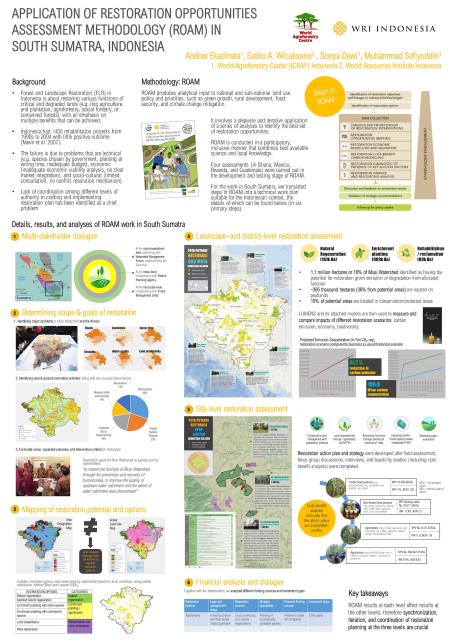Toward a successful forest and landscape restoration in Sumatra, Indonesia: the application of Restoration Opportunities Assessment Methodology

Presented at Regional Policy Dialogue on Connecting Finance and Policy: Forest Landscape Restoration in Southeast Asia, March 8, Bangkok Satrio A. Wicaksono (WRI Indonesia) Andree Ekadinata (ICRAF)
Restoring degraded lands and landscapes is essential for human livelihoods and well-being, long-term food security, biodiversity conservation, water regulation, and climate stability. Given the complex use and function of lands and landscapes, restoration is multifaceted and involves various stakeholders and strategies. To help guide restoration stakeholders systematically and comprehensively assess national and subnational restoration potential, the World Resources Institute (WRI) and the International Union for the Conservation of Nature (IUCN) developed a framework named Restoration Opportunities Assessment Methodology (ROAM).
The World Agroforestry Center (ICRAF) and WRI Indonesia have been testing and implementing ROAM within the Musi and Batanghari watersheds in Sumatra to strengthen regional capacity in the planning of forest and landscape restoration. The implementation of ROAM results in the identification of restoration intervention options, priority areas for restoration, cost and benefit calculation for each type of intervention, diagnosis of the presence of key success factors, strategies to overcome major obstacles for restoration, as well as financial analysis and financing options for restoration. Our ROAM analyses suggest that there is strong feedback between restoration planning at the macro-level (provincial or watershed), meso-scale (district), and micro-scale (forest management unit). Synchronization of restoration planning at all three levels is important so that restoration incentives can be effectively leveraged and past failures of restoration projects will not be repeated.